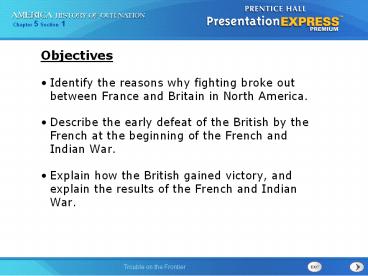Objectives - PowerPoint PPT Presentation
Title:
Objectives
Description:
Objectives Identify the reasons why fighting broke out between France and Britain in North America. Describe the early defeat of the British by the French at the ... – PowerPoint PPT presentation
Number of Views:95
Avg rating:3.0/5.0
Title: Objectives
1
Objectives
- Identify the reasons why fighting broke out
between France and Britain in North America. - Describe the early defeat of the British by the
French at the beginning of the French and Indian
War. - Explain how the British gained victory, and
explain the results of the French and Indian War.
2
Set Question What is a militia?
3
Terms and People
- George Washington Virginia colonist who led
troops against the French during the Seven Years
War future president - militia force made up of civilians trained as
soldiers but not part of the regular army - alliance agreement between countries to help
each other against other countries - cede surrender
4
How did the British gain French territory in
North America?
By the mid-1700s, both Britain and France had
claimed vast areas of land in North Americalands
long settled by Native Americans.
Conflicts over land led to war, with the future
of much of North America at stake.
5
In the 1750s, land disputes erupted in the Ohio
River valley, the area between Lake Erie and the
Ohio River.
6
The Virginia colony also claimed the land,
and British settlers continued to move west.
France claimed the Ohio River valley as part of
its territory.
7
In 1753, the French began building forts in the
Ohio River valley to protect their claims.
The governor of Virginia sent a militia led by
George Washington to order the French out.
The French ignored Washingtons warnings.
8
The next year, Washington returned to the Ohio
River valley to find the French building a fort
at a key location.
Ohio R.
9
(No Transcript)
10
Washington built a small fort of his own, Fort
Necessity, nearby.
A large French army attacked, forcing Washington
to surrender Fort Necessity.
The French sent Washington home with the message
that they would never give up the Ohio River
valley.
11
(No Transcript)
12
War with France seemed certain.
Hoping to form an alliance against the French,
the British called a meeting of colonial leaders
and local Iroquois tribes in Albany, New York.
The alliance failed.
Iroquois refuse to join a British alliance
British
13
Colonial leaders at the Albany Congress still
tried to work out a plan to defend themselves
against the French.
Benjamin Franklin urged the colonists to unite
against the enemy.
14
Franklin drew up a plan in which an elected
council would have authority to act for all the
colonies on urgent matters. It also could form
armies and collect taxes to pay expenses.
Albany Plan of Union
The Albany Plan of Union was rejected by the
colonial assemblies.
15
Despite the failure to form a united front, the
British decided it was time to act. In 1755,
troops led by General Edward Braddock marched on
Fort Duquesne.
The French and their Native American allies
ambushed the British, defeating them.
- The British knew little about fighting in North
America. - Red uniforms provided targets.
16
(No Transcript)
17
Brock, knock it off
18
The British disaster at Fort Duquesne was
followed by other defeats.
Fort Niagara Lake George Fort Oswego Fort William
Henry
In 1756, Britain declared war on France, marking
the official beginning of the Seven Years War.
19
Britains string of defeats finally ended when a
new prime minister, William Pitt, took office.
Pitts generals soon turned the tide of the war.
In 1758, the British won Fort Duquesne, renaming
it Fort Pitt. Such victories helped the British
gain Iroquois support.
Iroquois join a British alliance
British
20
The French and Indian War
British victories in 1758 and 1759 set the stage
for the key battle of the warthe Battle of
Quebec.
21
Quebec, the capital of New France, was located
atop high cliffs.
The British climbed the cliffs on an unguarded
trail and captured the city.
Without Quebec, France could no longer defend its
territory. In 1763, Britain and France signed the
Treaty of Paris, ending the war.
22
Under the terms of the treaty, France lost its
lands in North America.
Native Americans lost, too, as British settlers
continued to move west.
23
Section Questions 1. What land did the war start
over? 2. Why did Washingtons troops have
trouble firing their weapons from inside Fort
Necessity? 3. Why was Braddocks march down the
wooded trail a bad idea? 4. Why were the French
winning at the beginning of the war? 5. Who wins
the French and Indian War?
24
Ticket Out Question How did the French and
Indian War affect the Native Americans?
25
Section Review
Know It, Show It Quiz
QuickTake Quiz































